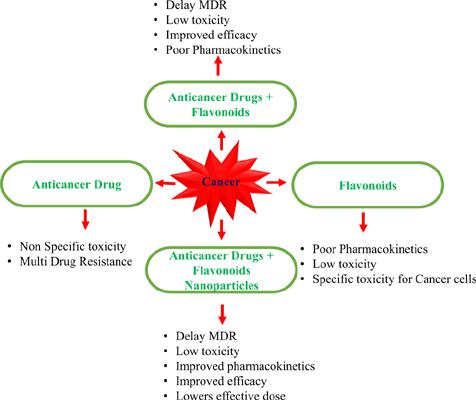Current Topics in Medicinal Chemistry ( IF 3.4 ) Pub Date : 2020-07-31 , DOI: 10.2174/1568026620666200502005411 Yusuf Hussain 1 , Suaib Luqman 1 , Abha Meena 1

|
Background: In chemotherapy for cancer, conventional drugs aim to target the rapidly growing and dividing cells at the early stages. However, at an advanced stage, cancer cells become less susceptible because of the multidrug resistance and the recruitment of alternative salvage pathways for their survival. Besides, owing to target non-selectivity, healthy proliferating cells also become vulnerable to the damage. The combination therapies offered using flavonoids to cure cancer not only exert an additive effect against cancer cells by targetting supplementary cell carnage pathways but also hampers the drug resistance mechanisms. Thus, the review aims to discuss the potential and pharmacokinetic limitations of flavonoids in cancer treatment. Further successful synergistic studies reported using flavonoids to treat cancer has been described along with potential drug delivery systems.
Methods: A literature search was done by exploring various online databases like Pubmed, Scopus, and Google Scholar with the specific keywords like “Anticancer drugs”, “flavonoids”, “oncology research”, and “pharmacokinetics”.
Results: Dietary phytochemicals, mainly flavonoids, hinder cell signalling responsible for multidrug resistance and cancer progression, primarily targeting cancer cells sparing normal cells. Such properties establish flavonoids as a potential candidate for synergistic therapy. However, due to low absorption and high metabolism rates, the bioavailability of flavonoids becomes a challenge. Such challenges may be overcome using novel approaches like derivatization, and single or co-delivery nano-complexes of flavonoids with conventional drugs. These new approaches may improve the pharmacokinetic and pharmacodynamic of flavonoids.
Conclusion: This review highlights the application of flavonoids as a potential anticancer phytochemical class in combination with known anti-cancer drugs/nanoparticles. It also discusses flavonoid’s pharmacokinetics and pharmacodynamics issues and ways to overcome such issues. Moreover, it covers successful methodologies employed to establish flavonoids as a safe and effective phytochemical class for cancer treatment.
中文翻译:

黄酮类化合物作为潜在抗癌药物的研究进展,包括与其他方法的协同作用。
背景:在癌症化学疗法中,常规药物的目标是在早期阶段靶向快速生长和分裂的细胞。然而,在晚期阶段,由于多药耐药性以及为了挽救其生存而招募了其他挽救途径,癌细胞变得较不易感染。此外,由于靶标的非选择性,健康的增殖细胞也容易受到损害。使用类黄酮治疗癌症所提供的联合疗法不仅通过靶向辅助细胞杀伤途径对癌细胞发挥累加效应,而且阻碍了耐药机制。因此,本综述旨在探讨类黄酮在癌症治疗中的潜力和药代动力学局限性。
方法:通过浏览各种在线数据库(例如Pubmed,Scopus和Google Scholar)进行文献搜索,并使用“抗癌药”,“类黄酮”,“肿瘤学研究”和“药代动力学”等特定关键字。
结果:饮食中的植物化学物质(主要是类黄酮)阻碍了引起多药耐药性和癌症进展的细胞信号传导,主要靶向保留正常细胞的癌细胞。这种性质将类黄酮确立为协同治疗的潜在候选者。然而,由于低吸收和高代谢率,类黄酮的生物利用度成为一个挑战。可以使用新颖的方法(例如衍生化以及类黄酮与常规药物的单或共递送纳米复合物)克服此类挑战。这些新方法可能会改善类黄酮的药代动力学和药效学。
结论:这篇综述强调了类黄酮与已知的抗癌药物/纳米颗粒联合应用作为潜在的抗癌植物化学类别的应用。它还讨论了类黄酮的药代动力学和药效学问题以及克服此类问题的方法。此外,它涵盖了用于将类黄酮确定为治疗癌症的安全有效的植物化学类别的成功方法。



























 京公网安备 11010802027423号
京公网安备 11010802027423号